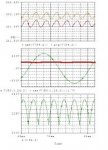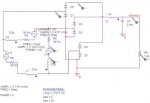SceneryDriver
Senior Member
- Location
- NJ
- Occupation
- Electrical and Automation Designer
All,
I posted this question over at plcs.net, and didn't really get a good answer so I'm asking here:
My transformer and rectifier math for 3-phase supply is a bit rusty.
I'm looking to design a nominal 70VDC power supply for a large number of servos. They require 75VDC, but with the number of servos I'm looking to run, the factory-supplied power supplies will consume too much room in the control cabinet, and be too heavy.
I'm looking at building a DC supply using:
(3) 1kva 48VAC secondary transformers wired together with a delta secondary (fed from a 208VAC 3-phase source)
(1) 3-phase, 60A bridge rectifier module
(2) 18,000uF filter caps
The transformers are rated at 234VAC primary, 48VAC secondary; if I feed this power supply from 208VAC, that should give me a ~42VAC secondary voltage.
I will rectify the outputs of the transformers, and if my math is right, I should get 42V x 1.65 = ~70VDC. With filtering caps, I should have a fairly solid DC supply. The servos have a 90VDC max rating, so I have plenty of headroom.
Is my math correct to derive my peak DC voltage, using the 1.65 multiplication factor for bridge rectified 3-phase voltage? Nominal DC voltage should be close to peak, with adequate filtering, yes?
My math came from this equation:

I'm also slightly unclear on what my ultimate capacity of the power supply will be; if the transformers' secondaries can each supply 20A, I should have 60A DC available, yes?
I haven't done much power supply design with a three-phase source (any, in fact). A single phase supplied DC supply would be easier, but it won't give me the capacity I need without a monster transformer.
Thanks for the help.
SceneryDriver
I posted this question over at plcs.net, and didn't really get a good answer so I'm asking here:
My transformer and rectifier math for 3-phase supply is a bit rusty.
I'm looking to design a nominal 70VDC power supply for a large number of servos. They require 75VDC, but with the number of servos I'm looking to run, the factory-supplied power supplies will consume too much room in the control cabinet, and be too heavy.
I'm looking at building a DC supply using:
(3) 1kva 48VAC secondary transformers wired together with a delta secondary (fed from a 208VAC 3-phase source)
(1) 3-phase, 60A bridge rectifier module
(2) 18,000uF filter caps
The transformers are rated at 234VAC primary, 48VAC secondary; if I feed this power supply from 208VAC, that should give me a ~42VAC secondary voltage.
I will rectify the outputs of the transformers, and if my math is right, I should get 42V x 1.65 = ~70VDC. With filtering caps, I should have a fairly solid DC supply. The servos have a 90VDC max rating, so I have plenty of headroom.
Is my math correct to derive my peak DC voltage, using the 1.65 multiplication factor for bridge rectified 3-phase voltage? Nominal DC voltage should be close to peak, with adequate filtering, yes?
My math came from this equation:

I'm also slightly unclear on what my ultimate capacity of the power supply will be; if the transformers' secondaries can each supply 20A, I should have 60A DC available, yes?
I haven't done much power supply design with a three-phase source (any, in fact). A single phase supplied DC supply would be easier, but it won't give me the capacity I need without a monster transformer.
Thanks for the help.
SceneryDriver



